Signals and systems electrical engineering miscellaneous
- A sinusoid x(t) of unknown frequency is sampled by an impulse train of period 20 ms. The resulting sample train is next applied to an ideal lowpass filter with a cutoff at 25 Hz. The filter output is seen to be a sinusoid of frequency 20 Hz. This means that x(t) has a frequency of
-
View Hint View Answer Discuss in Forum
Sampling rate 50 Hz
Let x(t) has a frequency of fx Hz,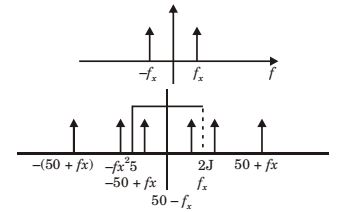
After sampling with 50 Hz spectrum will be LPF of cut off = 25 Hz
output = 20 Hz
⇒ 50 – fx = 20
⇒ fx = 30 Hz Sampling rate 50 Hz
Let x(t) has a frequency of fx Hz,
After sampling with 50 Hz spectrum will be LPF of cut off = 25 Hz
output = 20 Hz
⇒ 50 – fx = 20
⇒ fx = 30 HzCorrect Option: C
Sampling rate 50 Hz
Let x(t) has a frequency of fx Hz,
After sampling with 50 Hz spectrum will be LPF of cut off = 25 Hz
output = 20 Hz
⇒ 50 – fx = 20
⇒ fx = 30 Hz
- A continuous-time LTI system with system function H(ω) has the following pole-zero plot. For this system, which of the alternatives is TRUE?
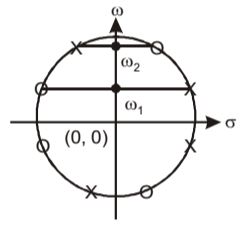
-
View Hint View Answer Discuss in Forum
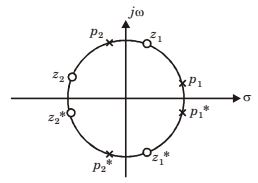
The transfer function can be written asH(s) = (s - z1)(s - z1*)(s - z2)(s - z2*) (s - P1)(s - P1*)(s - P2)(s - P2*) |H(jω)| = √ω² + |z1|²√ω² + |z1|²√ω² + |z2|²√ω² + |z2|² √s² + |p1|²√ω² + |p1|²√ω² + |p2|²√ω² + |p2|²
from figure |z1| = |p2|
|z2| = |p1|
⇒ (H(jω)) = K [constant]Correct Option: D

The transfer function can be written asH(s) = (s - z1)(s - z1*)(s - z2)(s - z2*) (s - P1)(s - P1*)(s - P2)(s - P2*) |H(jω)| = √ω² + |z1|²√ω² + |z1|²√ω² + |z2|²√ω² + |z2|² √s² + |p1|²√ω² + |p1|²√ω² + |p2|²√ω² + |p2|²
from figure |z1| = |p2|
|z2| = |p1|
⇒ (H(jω)) = K [constant]
- A signal is represented by
x(t) = 
1 |t| < 1 0 |t| > 1
The Fourier transform of the convolved single y(t) = x(2t)*x(t/2) is
-
View Hint View Answer Discuss in Forum
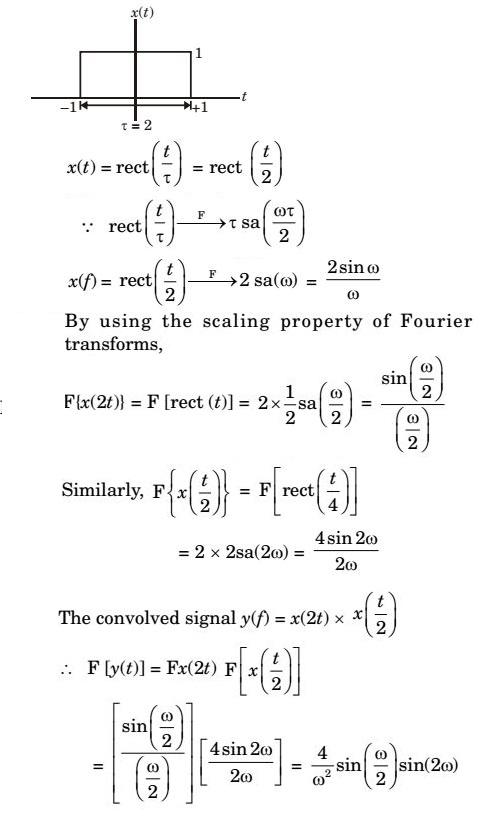
Correct Option: A

- A function ƒ(t) is shown in the figure.
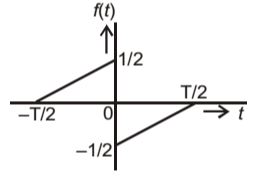
The Fourier transform F(ω) of ƒ(t) is
-
View Hint View Answer Discuss in Forum
Since ƒ(t) is odd and real
ƒ(t) = – ƒ(– t)
∮ F(ω) is imaginary and odd [symmetry property of fourier Transform]Correct Option: C
Since ƒ(t) is odd and real
ƒ(t) = – ƒ(– t)
∮ F(ω) is imaginary and odd [symmetry property of fourier Transform]
- A 10 kHz even-symmetric square wave is passed through a bandpass filter with centre frequency at 30 kHz and 3 dB passband of 6 kHz. The filter output is
-
View Hint View Answer Discuss in Forum
NA
Correct Option: C
NA

